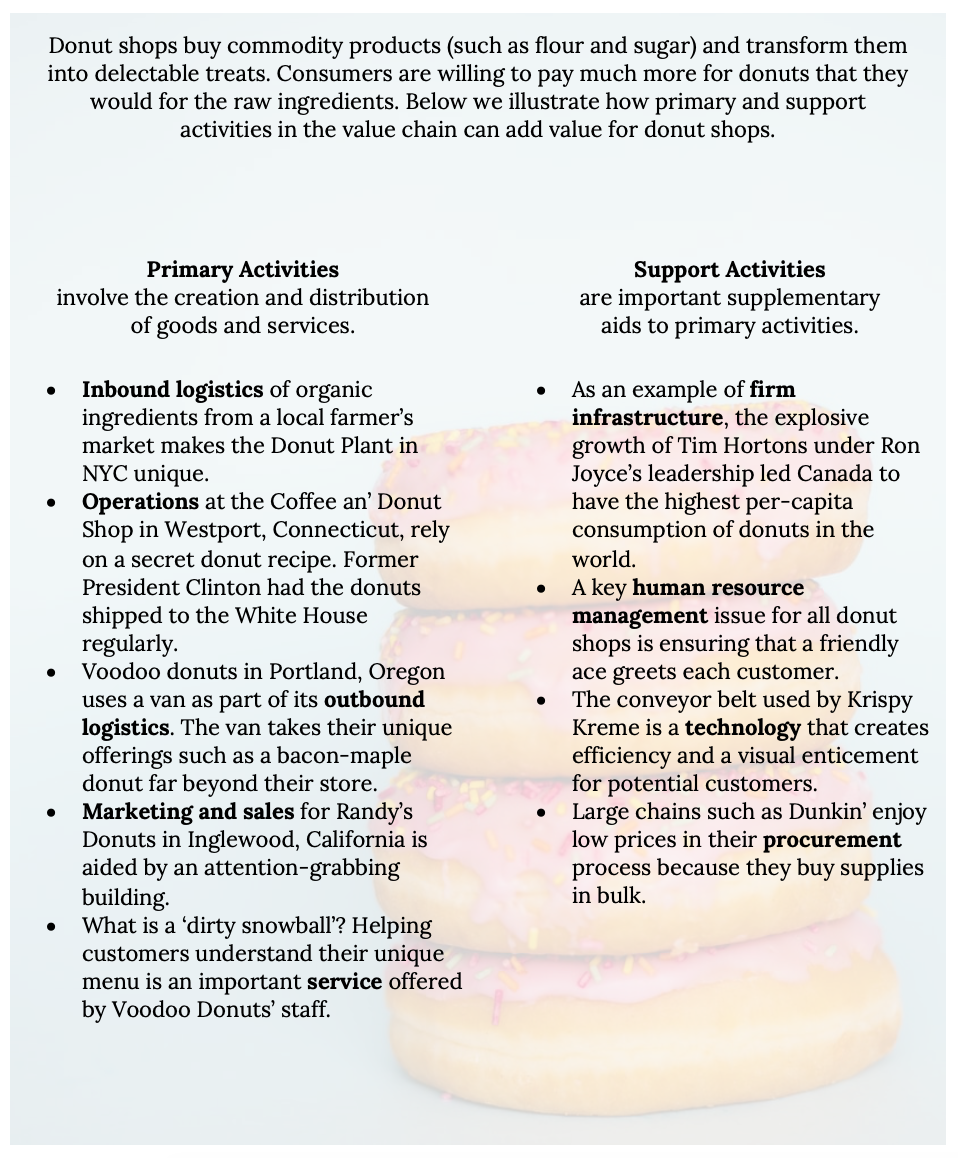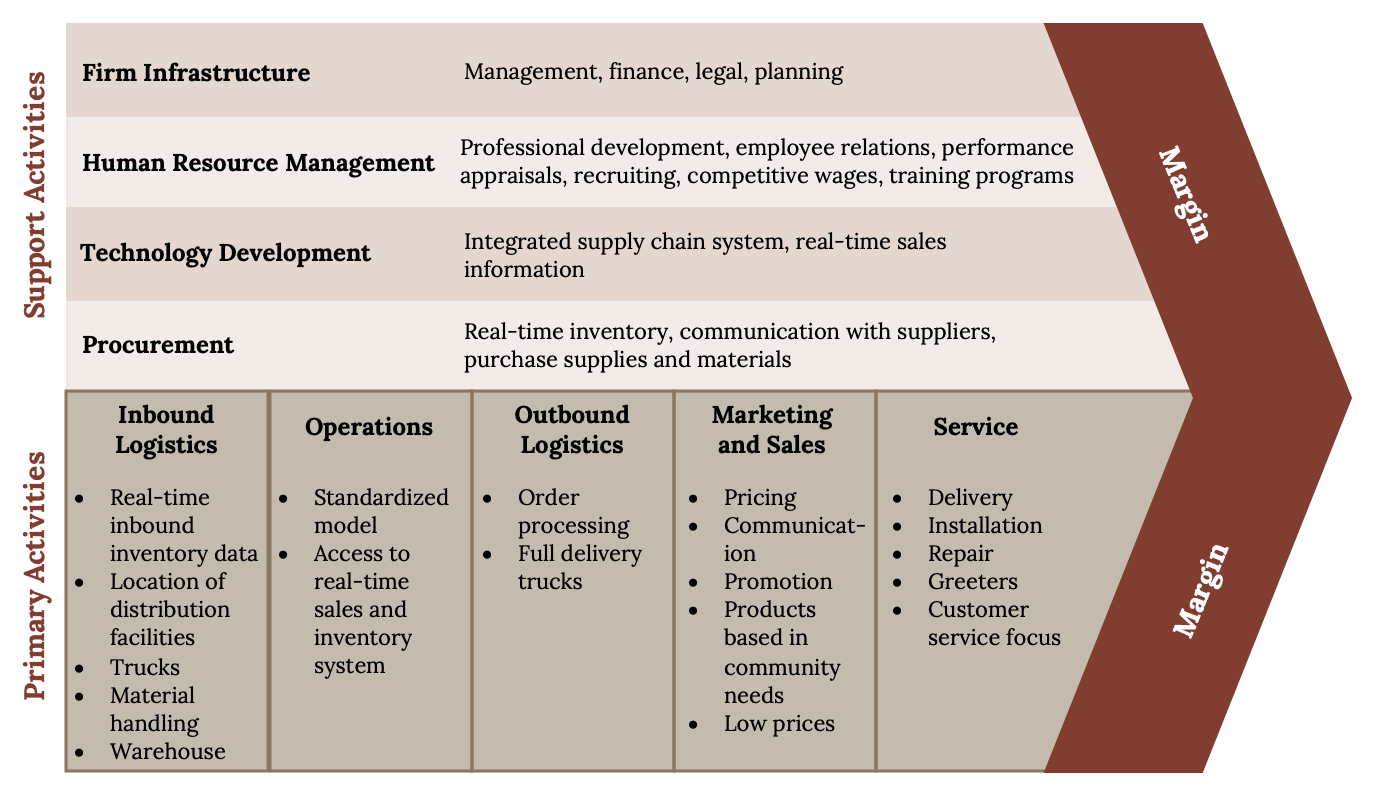4.5 Value Chain

Elements of the Value Chain
When executives choose strategies, an organization’s resources and capabilities should be examined alongside consideration of its value chain. A value chain charts the path by which products and services are created and eventually sold to customers (Porter, 1985). The term value chain reflects the fact that, as each step of this path is completed, the product becomes more valuable than it was at the previous step (Table 4.10). Within the lumber business, for example, value is added when a tree is transformed into usable wooden boards; the boards created from a tree can be sold for more money than the price of the tree.
The Value Chain is used as an internal assessment tool to help a firm determine where it might be able to achieve a competitive advantage. In which areas of the primary and secondary activities is the firm particularly strong? Can that activity be leveraged to provide a competitive advantage over its rivals? Resources and/or capabilities within that activity can be evaluated using the VRIO framework to determine what type of competitive advantage they provide. For example, Netflix was the first firm to leverage its technology development support activity to bring high quality movies to customers through streaming. Being the first mover in this industry gave Netflix a foothold and reputation in this industry, and others have not been able to catch up. When using this tool for internal assessment, each activity of the Value Chain should be examined for its potential to achieve a competitive advantage. Conversely, weak activities in the Value Chain are opportunities to improve organizational performance. The overall intent of the Value Chain is to produce a profit margin for the firm.

Value chains include both primary and secondary activities. Primary activities are actions that are directly involved in creating and distributing goods and services. Consider a simple illustrative example: doughnut shops. Doughnut shops transform basic commodity products such as flour, sugar, butter, and grease into delectable treats. Value is added through this process because consumers are willing to pay much more for doughnuts than they would be willing to pay for the underlying ingredients.
There are five primary activities. Inbound logistics refers to the arrival of raw materials. Although doughnuts are seen by most consumers as notoriously unhealthy, the Doughnut Plant in New York City has carved out a unique niche for itself by obtaining organic ingredients from a local farmer’s market. Operations refers to the actual production process, while outbound logistics tracks the movement of a finished product to customers. Referring back to Southwest Airlines, one of Southwest Airlines’ unique capabilities is moving passengers more quickly than its rivals. This advantage in operations is based in part on Southwest’s reliance on one type of airplane (which speeds maintenance) and its avoidance of advance seat assignments (which accelerates the passenger boarding process).
Attracting potential customers and convincing them to make purchases is the domain of marketing and sales. For example, people cannot help but notice Randy’s Donuts in Inglewood, California, because the building has a giant doughnut on top of it. Finally, service refers to the extent to which a firm provides assistance to their customers. Voodoo Donuts in Portland, Oregon, has developed a clever website (voodoodoughnut.com) that helps customers understand their uniquely named products, such as the Voodoo Doll, the Texas Challenge, the Memphis Mafia, and the Dirty Snowball.
Secondary activities are not directly involved in the evolution of a product, but instead provide important underlying support for primary activities. Firm infrastructure refers to how the firm is organized and led by executives. The effects of this organizing and leadership can be profound. For example, Ron Joyce’s leadership of Canadian doughnut shop chain Tim Hortons was so successful that Canadians consume more doughnuts per person than all other countries. In terms of resource-based theory, Joyce’s leadership was clearly a valuable and rare resource that helped his firm prosper.
Human resource management is also important. Human resource management involves the recruitment, training, and compensation of employees. A recent research study used data from more than twelve thousand organizations to demonstrate that the knowledge, skills, and abilities of a firm’s employees can act as a strategic resource and strongly influence the firm’s performance (Crook et al., 2011). Certainly, the unique level of dedication demonstrated by employees at Southwest Airlines has contributed to that firm’s excellent performance over several decades.
Technology refers to the use of computerization and telecommunications to support primary activities. Although doughnut making is not a high-tech business, technology plays a variety of roles for doughnut shops, such as allowing customers to pay using credit cards.
Procurement is the process of negotiating for and purchasing raw materials. Large doughnut chains such as Dunkin’ and Krispy Kreme can gain cost advantages over their smaller rivals by purchasing flour, sugar, and other ingredients in bulk. Meanwhile, Southwest Airlines has gained an advantage over its rivals by using futures contracts within its procurement process to minimize the effects of rising fuel prices.
Sometimes competitive advantage is achieved from the support activities of a firm as opposed to the primary activities. Superior technology development or human resource management can produce a temporary if not a sustained competitive advantage. A strong research and development arm in a pharmaceutical company can develop medications that are patented and cannot be imitated. Incentives to staff such as those provided by 3M and Google to be creative and develop new products have resulted in a competitive advantage.
Section Video
Strategic Management: Value Chain Analysis [04:41]
The video for this lesson further discusses value chain analysis.
You can view this video here: https://youtu.be/Tpb1fxt9YfU.
Key Takeaway
- The value chain provides a useful tool for managers to examine systematically where value may be added to their organizations. This tool is useful in that it examines key elements in the production of a good or service, as well as areas in which value may be added in support of those primary activities.
Exercises
- If you were hired as a consultant for your university, what specific element of the value chain would you seek to improve first?
- What local business in your town could be improved most dramatically by applying the value chain? Would improvements of primary or support activities help to improve this firm most? Could knowledge of strategic supply chain management add further value to this firm?
References
Crook, T. R., Todd, S. Y., Combs, J. G., Woehr, D. J., & Ketchen, D. J. (2011). Does human capital matter? A meta-analysis of the relationship between human capital and firm performance. Journal of Applied Psychology, 96(3), 443–456.
Porter, M. E. (1985). Competitive advantage: Creating and sustaining superior performance. Free Press.
Image Credits
Figure 4.11: Kindred Grey (2020). “Adding value within a value chain.” CC BY NC SA 4.0. Image of donut: Annie Spratt (2016). “Stacked donuts.” Public Domain. Retrieved from: https://unsplash.com/photos/AjTclDIadpg Adaptation of Figure 4.10 from Mastering Strategic Management (2015) (CC BY NC SA 4.0). Retrieved from https://open.lib.umn.edu/app/uploads/sites/11/2015/04/9c5437a4d7bfd1ad4b0baa480978c7bd.jpg.
Figure 4.12: Kindred Grey (2020). “The value chain.” CC BY NC SA 4.0. Adaptation of Figure 4.11 from Mastering Strategic Management (2015) (CC BY NC SA 4.0). Retrieved from https://open.lib.umn.edu/app/uploads/sites/11/2015/04/b38d1270a489c447e16e30df24d931aa.jpg.
Video Credits
Melissa Schilling. (2020, May 25). Strategic management: Value chain analysis [Video]. YouTube. https://youtu.be/Tpb1fxt9YfU.
The path and steps by which products and services are created and eventually sold to customers, including supporting activities
A tool used to assess if a firm’s resource or capability is Valuable, Rare, Difficult to Imitate, and Organized to create value, and therefore what type of competitive advantage it provides.

